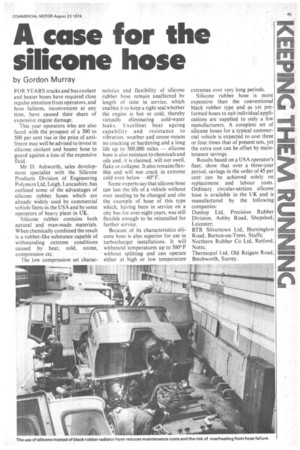A case for the
Page 49

If you've noticed an error in this article please click here to report it so we can fix it.
silicone hose
by Gordon Murray
FOR YEARS trucks and bus coolant and heater hoses have required close regular attention from operators, and hose failures, inconvenient at any time, have caused their share of expensive engine damage.
This year operators who are also faced with the prospect of a 300 to 500 per cent rise in the price of antifreeze may well be advised to invest in silicone coolant and heater hose to guard against a loss of the expensive fluid.
Mr D. Ashworth, sales development specialist with the Silicone Products Division of Engineering Polymers Ltd, Leigh, Lancashire, has outlined some of the advantages of silicone rubber. hoses which are already widely used by commercial vehicle fleets in the USA and by some operators of heavy plant in UK.
Silicone rubber contains both natural and man-made materials. When chemically combined the result is a rubber-like substance capable of withstanding extreme conditions caused by heat, cold, ozone, compression etc.
The low compression set charac teristics and flexibility of silicone rubber hose remain unaffected by length of time in service, which enables it to keep a tight seal whether the engine is hot or cold, thereby virtually eliminating cold-water leaks. Excellent heat ageing capability and resistance to vibration, weather and ozone means no cracking or hardening and a long life up to 500,000 miles — silicone hose is also resistant to chemicals and oils and, it is claimed, will not swell, flake or collapse. It also remains flexible and will not crack in extreme cold even below --60°F.
Some experts say that silicone hose can last the life of a. vehicle without ever needing to be changed and cite the example of hose of this type which, having been in service on a city bus for over eight years, was still flexible enough to be reinstalled for further service.
Because of its characteristics silicone hose is also superior for use in turbocharger installations. It will withstand temperatures up to 500°F without splitting and can operate either at high or low temperature extremes over very long periods.
Silicone rubber hose is more expensive than the conventional black rubber type and as yet prefortned hoses to suit individual applications are supplied to only a few manufacturers. A complete set of silicone hoses for a typical commer cial vehicle is expected to cost three or four times that of present sets, yet the extra cost can be offset by maintenance savings.
Results based on a USA operator's fleet, show that over a three-year period, savings in the order of 45 per cent can be achieved solely on replacement and labour costs. Ordinary circular-section silicone hose is available in the UK and is manufactured by the following companies: Dunlop Ltd, Precision Rubber Division, Ashby Road, Shepshed, Leicester; BTR Silvertown Ltd, Horninglow Road, Burton-on-Trent, Staffs; Northern Rubber Co Ltd, Retford, Notts; Thermopol Ltd, Old Reigate Road, Betchworth, Surrey.






























































































